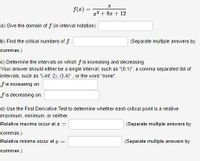
Calculus: Early Transcendentals
8th Edition
ISBN: 9781285741550
Author: James Stewart
Publisher: Cengage Learning
expand_more
expand_more
format_list_bulleted
Question

Transcribed Image Text:f(z) =
z2 + 8z + 12
a) Give the domain of f (in interval notation)
b) Find the critical numbers of f.
(Separate multiple answers by
commas.)
c) Determine the intervals on which f is increasing and decreasing.
Your answer should either be a single interval, such as "(0,1)", a comma separated list of
intervals, such as "(-inf, 2), (3,4)", or the word "none".
f is increasing on:
f is decreasing on:
d) Use the First Derivative Test to determine whether each critical point is a relative
maximum, minimum, or neither.
Relative maxima occur at z =
(Separate multiple answers by
commas.)
Relative minima occur at z =
(Separate multiple answers by
commas.)
Expert Solution
This question has been solved!
Explore an expertly crafted, step-by-step solution for a thorough understanding of key concepts.
This is a popular solution
Trending nowThis is a popular solution!
Step by stepSolved in 3 steps with 1 images

Knowledge Booster
Similar questions
- What do I do for this?arrow_forwardFind the domain and range of the given function algebraically. f(x) = 6 + 2√x - 5 o D: [5,00) OD: [-5,00) OD: (5,00) OD: [5,00) R: [5,00) R: [6,00) R: (6,00) R: [6,00) نے 7arrow_forwardIdentify where the function f(x) = x³ – 4x? + 8x + 1 is increasing, decreasing, concave up, and concave down. (Give your answer as an interval in the form (*,*). Use the symbol o for infinity, U for combining intervals, and an appropriate type of parentheses "(",")", "[", or "]" depending on whether the interval is open or closed. Express numbers in exact form. Use symbolic notation and fractions where needed. Enter DNE if no such interval exists.) f is increasing on: f is decreasing on: f is concave up on: f is concave down on: Use the graphing utility to graph f. f(x) = 20 y + 10 -20 -10 10 20 -10 powered by Sousep -20arrow_forward
Recommended textbooks for you
 Calculus: Early TranscendentalsCalculusISBN:9781285741550Author:James StewartPublisher:Cengage Learning
Calculus: Early TranscendentalsCalculusISBN:9781285741550Author:James StewartPublisher:Cengage Learning Thomas' Calculus (14th Edition)CalculusISBN:9780134438986Author:Joel R. Hass, Christopher E. Heil, Maurice D. WeirPublisher:PEARSON
Thomas' Calculus (14th Edition)CalculusISBN:9780134438986Author:Joel R. Hass, Christopher E. Heil, Maurice D. WeirPublisher:PEARSON Calculus: Early Transcendentals (3rd Edition)CalculusISBN:9780134763644Author:William L. Briggs, Lyle Cochran, Bernard Gillett, Eric SchulzPublisher:PEARSON
Calculus: Early Transcendentals (3rd Edition)CalculusISBN:9780134763644Author:William L. Briggs, Lyle Cochran, Bernard Gillett, Eric SchulzPublisher:PEARSON Calculus: Early TranscendentalsCalculusISBN:9781319050740Author:Jon Rogawski, Colin Adams, Robert FranzosaPublisher:W. H. Freeman
Calculus: Early TranscendentalsCalculusISBN:9781319050740Author:Jon Rogawski, Colin Adams, Robert FranzosaPublisher:W. H. Freeman
 Calculus: Early Transcendental FunctionsCalculusISBN:9781337552516Author:Ron Larson, Bruce H. EdwardsPublisher:Cengage Learning
Calculus: Early Transcendental FunctionsCalculusISBN:9781337552516Author:Ron Larson, Bruce H. EdwardsPublisher:Cengage Learning

Calculus: Early Transcendentals
Calculus
ISBN:9781285741550
Author:James Stewart
Publisher:Cengage Learning

Thomas' Calculus (14th Edition)
Calculus
ISBN:9780134438986
Author:Joel R. Hass, Christopher E. Heil, Maurice D. Weir
Publisher:PEARSON

Calculus: Early Transcendentals (3rd Edition)
Calculus
ISBN:9780134763644
Author:William L. Briggs, Lyle Cochran, Bernard Gillett, Eric Schulz
Publisher:PEARSON

Calculus: Early Transcendentals
Calculus
ISBN:9781319050740
Author:Jon Rogawski, Colin Adams, Robert Franzosa
Publisher:W. H. Freeman


Calculus: Early Transcendental Functions
Calculus
ISBN:9781337552516
Author:Ron Larson, Bruce H. Edwards
Publisher:Cengage Learning